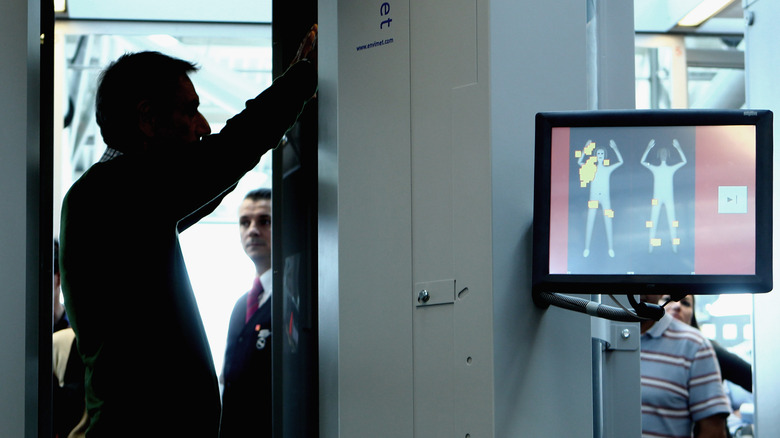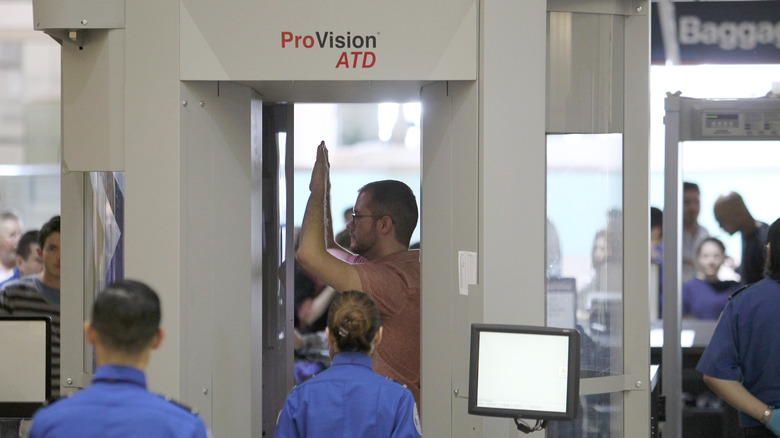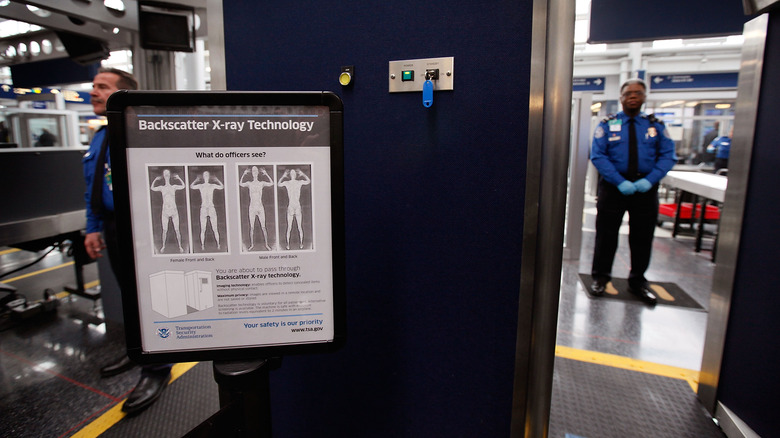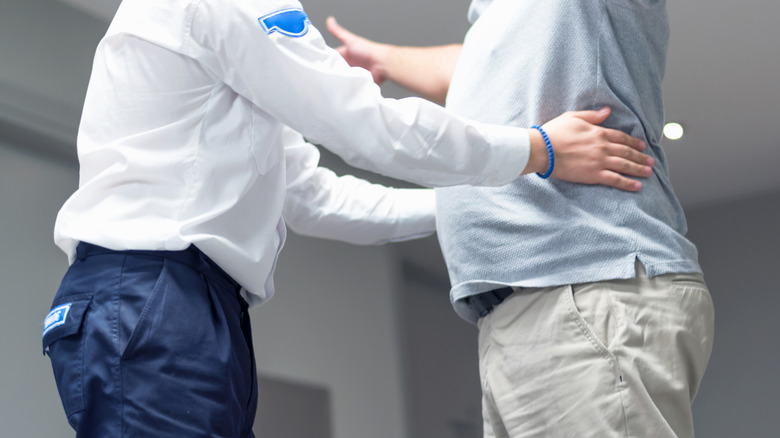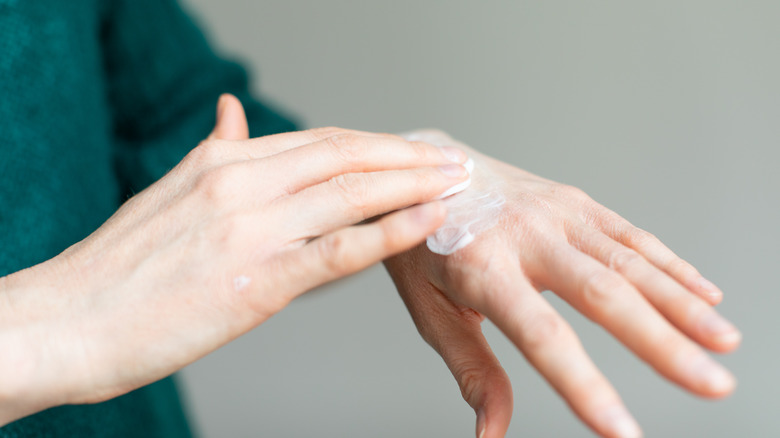What Full-Body Scanners At Airport Security Really Show
If you've ever traveled by plane, you know the drill that awaits you at the airport before boarding your flight. That's right, we're talking about TSA's security screening. Of course, prepping for security usually happens long before you arrive at the airport. Think of the 3-1-1 liquids rule for carry-on baggage, though you can sometimes skate around TSA liquid rules using one game-changing hack. Nevertheless, here's the typical process: Your items are sent through an X-ray, and you, a full-body scanner. This ensures that travelers don't have weapons, explosives, or any other perilous and prohibited items.
You enter the machine, and in a matter of seconds, the ordeal is over. If you are curious to know what TSA sees for those few moments you're inside the scanner, here's the scoop. On their screen, the shape of a person will appear, and that's it. No, the full-body scanner does not produce images of an individual naked. If nothing sets off the full-body scanner, you're good to go. However, if something does, the screen will light up and pinpoint the area on your body where the trigger is coming from. Another thing to note: Full-body scanners cannot see the inside of your body
The science behind full-body scanners
Full-body scanners were first implemented at airports in the 2000s. However, they became a standard security measure after a Nigerian man on a flight from Amsterdam to Detriot attempted but failed to detonate an explosive he had in his underwear. That said, the airport's full-body scanners use millimeter wave imaging, which uses electromagnetic radiation.
Speaking to Reader's Digest, TSA expert Shawna Malvini Redden revealed how millimeter wave imaging works. She said, "The waves go through clothing and reflect off the passenger's skin (and whatever else is concealed) and bounce back an image, which is interpreted by the machine." For this reason, full-body scanners are more effective than metal detectors, which are also commonly used at airports for security screening.
Unlike metal detectors, full-body scanners that utilize millimeter-wave imaging can identify if an individual is hiding something they shouldn't be in their clothing. While millimeter-wave imaging is now the airport guideline, this wasn't always the case. Up until 2013, backscatter machines were also used as full-body scanners. They essentially do the same as millimeter-wave scanners but use X-ray technology instead. However, there's a reason why backscatter machines were phased out of airports.
The issue with backscatter machines
From 2010 until 2013, travelers could find backscatter machines at airport security. Why was their reign so shortlived? Simply put, they were deemed too controversial. Backscatter machines could produce an image of a silhouette with genitalia and other discerning features. In a 2014 article written in Politico, Jason Harrington, who worked for TSA from 2007 until 2013, revealed that piercings and even hernias could be seen on these full-body scanners. Needless to say, this was seen as a threat to privacy.
In addition, there were concerns that the machines were saving the images they were taking of travelers. According to a 2014 study published in the Archives of Internal Medicine (via Medscape), millimeter-wave scanners suffered from the same issues in the early years of their implementation. They, too, could produce a revealing image of the individual being scanned.
Eventually, due to objections from the public, as reported by NBC News, privacy filters were added to millimeter-wave scanners. This is why they now only show the silhouette of an individual and nothing else. Problem solved. However, the same can't be said about backscatter machines. The technology could not be applied to them. Thus, in early 2013, TSA decided to do away with backscatter machines for good.
Are full-body scanners bad for you?
Given that millimeter-wave scanners use radiation, there have been questions about the health implications of going through these scanners. Some even believe that they could injure DNA. However, you can rest assured that this is not the case. Millimeter-wave scanners employ small doses of non-ionizing radiation. This is not as harmful as ionizing radiation, which is known to cause cancer.
Speaking to TIME in 2017, David Brenner from Columbia University Medical Center stated, "Scientists can never say that something is 100% safe, but I would say there's no plausible evidence by which millimeter waves could damage DNA." He added, "If the risks are there, they're extremely small." If you need more reassurance, Lewis Nelson, from Rutgers New Jersey Medical School, told Live Science in 2019 that travelers receive more radiation on a flight than from a full-body scanner. The same can be said about medical X-rays. Note that X-rays do use ionizing radiation.
With this in mind, there's another reason to thank TSA for getting rid of backscatter machines: They also use ionizing radiation. A study published in the Archives of Internal Medicine (via Medscape) notes that backscatter machines could increase the risk of cancer. As a result, Europe stopped using them in 2011.
Is there an alternative to full-body scanners?
If you don't want to go through a full-body scanner at the airport, here is some good news: You don't have to. Of course, this does not mean you can skip out on all security measures. You must undergo a pat-down screening if you decide against the full-body scanners. If you have never experienced this before, here's what to expect. While it can be awkward for a stranger to touch you, know that a TSA officer of the same gender as you will do the pat-down.
In addition, the TSA agent will wear clean gloves and explain the procedure to you. If they need to touch you in private areas, they will use the backs of their hands. Note that you can ask the TSA officer if he can conduct the pat-down in a private room. If this is the case, another TSA agent will be in the room, and you can bring someone with you.
Here are some other things to keep in mind. If you go through the full-body scanner and set it off, you must be patted down. If you see SSSS on your boarding pass, this means you've been randomly selected for further security screening and will likely be subject to a pat-down.
Surprising things that can trigger full-body scanners
If you want to avoid making airport security mistakes that could slow you down, know what can unexpectedly set off full-body scanners. Surprisingly, glycerin, traditionally used as a skin moisturizer in lotion, soap, baby wipes, and more, has been known to cause false alarms. The full-body scanner can mistake glycerin for an explosive substance. That's because the compound can be used to make dynamite and bombs. If this is the case, your hands might be swabbed for further testing. If you know any product you might be using has glycerin, thoroughly wash your hands to avert this mishap.
Medical devices like pacemakers could cause a false alarm. If you have a pacemaker, let TSA know before you enter a full-body scanner. While they might allow you to proceed with the full-body scanner screening, they could use an alternative procedure, such as a pat-down. If you're worried that your pacemaker might be affected by the full-body scanner, fear not; they do not. The same can be said about individuals with implantable cardioverter-defibrillators (ICDs).
Sweat is also known to set off full-body scanners. TSA expert Shawna Malvini Redden explained to Reader's Digest, "It has to do with millimeter wave technology and how the waves bounce off water." Lastly, underwire bras and certain hairstyles, like braids and dreadlocks, can trigger full-body scanners due to their thickness.
